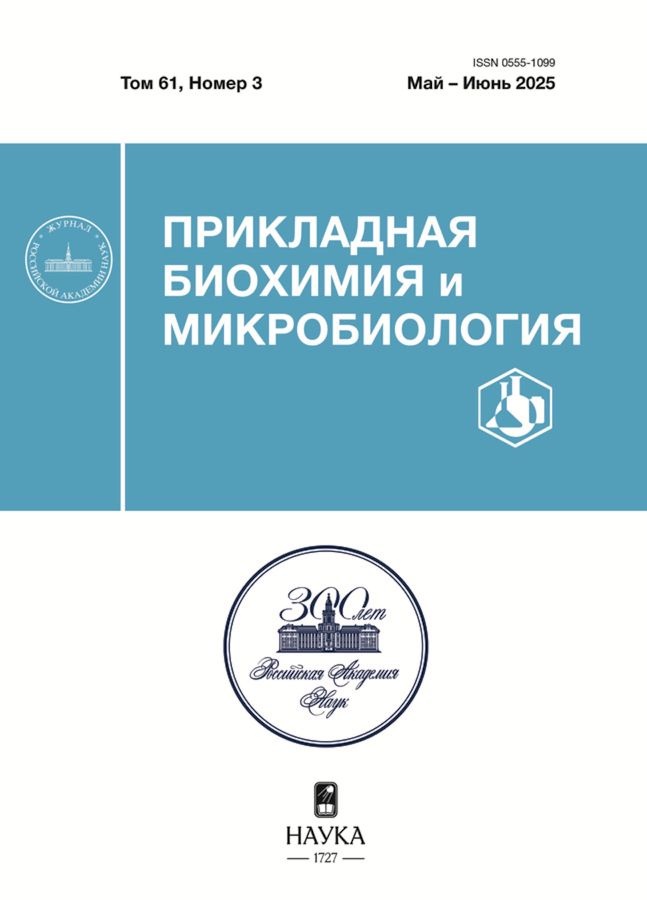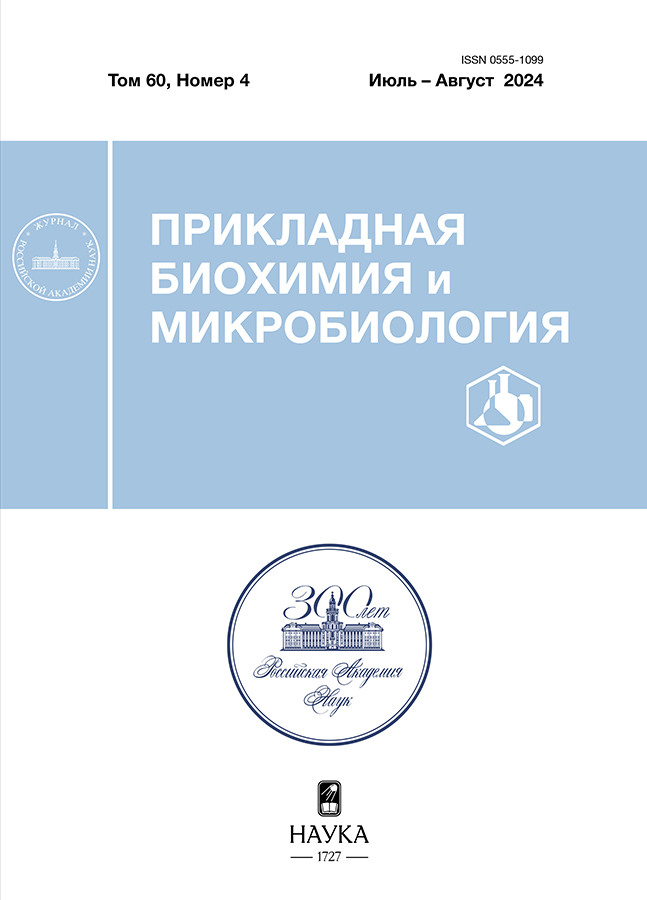Том 60, № 4 (2024)
Статьи
Иммуноанализ с использованием полноразмерных и фаговых антител для обнаружения антибиотиков (обзор)
Аннотация
Широкое применение антибиотиков, приводящее к антибиотикорезистентности и появлению антибиотиков в окружающей среде и продуктах питания, стимулирует развитие новых методов контроля антибактериальных препаратов в объектах окружающей среды. Одно из перспективных направлений по развитию методов определения антибиотиков принадлежит сенсорным технологиям. Ключевым моментом при развитии сенсорных систем является подбор чувствительного (распознающего) элемента. Одним из самых популярных методов распознавания антибиотиков является использование антител. В работе представлены основные иммуносенсорные системы, основанные на регистрации взаимодействия “антиген-антитело” и показаны преимущества и недостатки использования поликлональных и моноклональных антител. Отдельно описана возможность применения фаговых антител для определения антибиотиков.
 325-339
325-339


Оптимизация биосинтеза масляной кислоты из глюкозы по обращенному β-окислению жирных кислот рекомбинантными штаммами Escherichia coli
Аннотация
Оптимизирован биосинтез масляной кислоты из глюкозы рекомбинантными штаммами Escherichia coli по обращенному β-окислению жирных кислот. Повышенный выход целевого соединения достигнут при экспрессии генов atoB, fadB и fadE/fabI в базовом штамме MG∆4 PL-tesB ΔyciA (MG1655 ∆ackA-pta, ∆poxB, ∆ldhA, ∆adhE, PL-SDj10-tesB, ∆yciA) в составе плазмид. Продемонстрировано положительное влияние форсированного гидролиза АТФ на микроаэробную конверсию рекомбинантами углеводного субстрата в конечный продукт. Активация в клетках футильного цикла пировиноградная кислота – фосфоенолпируват – пировиноградная кислота, за счет усиления экспрессии гена ppsA, обеспечивала выраженный рост потребления рекомбинантами глюкозы и приводила к росту молярного выхода масляной кислоты до 39.5%. При разобщении компонентов H+-АТФ синтазного комплекса, вследствие делеции генов atpFH, молярный выход масляной кислоты из глюкозы, продемонстрированный штаммом, формирующим бутирил-КоА под действием еноил-АЦП редуктазы FabI, достигал 46%.
 340-347
340-347


Исследование влияния различных протеолитических ферментных препаратов отечественного производства на органолептические свойства изолятов белка гороха
Аннотация
В работе исследовано влияние четырех ферментных препаратов (ФП): Бациллолизина, Агропрота, Протозима и Протозима С (Россия), белковый и пептидный профили белкового изолята, выделенного из гороха сорта Фокор, а также на его запах и вкус. Показано, что обработка ферментами позволяет улучшить запаховые характеристики изолята. Так, удалось заметно понизить выраженность запаха бобовых и травянистого запаха. В то же время ферментная обработка позволяла улучшить также и вкус изолята: удалось весьма существенно уменьшить выраженность таких мешающих привкусов, как бобовый, терпкий, горький и травянистый. Полученные результаты позволили подобрать ФП (грибная кислая аспартатная протеаза) для улучшения органолептических параметров изолятов горохового белка, предназначенных для изготовления аналогов мясных и молочных продуктов.
 348-355
348-355


Наночастицы платины в водных растворах сополимера хитозан-винилпирролидона: синтез и биологическая активность
Аннотация
Получены привитые сополимеры хитозан-винилпирролидона водорастворимые при pH среды 6.8–7.5. Разработана методика получения агрегативно устойчивой системы наночастиц платины в растворах сополимера со средними размерами ~ 4 нм. Исследованы теплофизические, структурные характеристики порошкообразной композиции наночастицы платины-сополимер. Выполнено сопоставление in vitro противоопухолевой активности растворов разработанной композиции и цисплатина при одинаковой концентрации платины. Выявлено, что в отношении культуры раковых клеток HeLa Kyoto и A431 композиция по эффективности уступает цисплатину в пять и два раза соответственно. Наряду с этим эффект подавления роста клеток фибробластов линии hTERT BJ-5TA композиции в 17 раз меньше, чем у цисплатина, что допускает использование ее при повышенной концентрации и разработку противоопухолевого средства с наночастицами платины соизмеримого по результативности с цисплатином.
 356-365
356-365


Динамика уровней шаперонов HSP70 цитоплазмы и HSP70B хлоропластов при тепловом стрессе отличается у трех видов тыквы с разной устойчивостью к стрессам
Аннотация
Первой линией защиты у растений при стрессе является шаперонная система клетки. В настоящей работе изучено действие теплового стресса на уровни шаперонов HSP70 цитоплазмы и HSP70B хлоропластов трех видов Cucurbita (C. maxima Duchesne, C. pepo L. и C. moschata, Duchesne), различающихся по устойчивости к стрессам. Установлена взаимосвязь между уровнями шаперонов HSP70 цитоплазмы и HSP70В хлоропластов и видовой принадлежностью растений тыквы в условиях теплового стресса. При стрессе отмечено значительное повышение уровня шаперонов в клетках растений тыквы C. maxima – уровень HSP70 цитоплазмы возрос в 3.6 раза, а уровень HSP70В хлоропластов – в 2 раза. Тепловой стресс вызывал увеличение в 1.7 раза уровень цитоплазматического шаперона HSP70 в клетках растений тыквы C. pepo, а значимого изменения уровня белка HSP70В отмечено не было. Однако в результате действия теплового стресса на растения тыквы dblf C. moschata выявлено уменьшение уровней HSP70 и HSP70В по сравнению с уровнем у необработанных растений. Динамика изменения уровней шаперонов цитоплазмы и хлоропластов при действии теплового стресса аналогичная. Следует отметить, что конститутивный уровень в нормальных условиях HSP70 и HSP70В у С. moschata и C. рepo более высокий по сравнению C. maxima. Анализ полученных данных выявил интересную закономерность: высокие конститутивные уровни HSP приводят к незначительной индукции HSP и наоборот – низкий конститутивный уровень этих белков коррелирует с высокой индукцией этих белков после действия теплового стресса. Полученные данные важны для понимания механизмов устойчивости растений к стрессам и могут быть полезны для отбора и создания высокоустойчивых продуктивных сортов сельскохозяйственно-значимых растений.
 366-374
366-374


Филогения и характеристика эндофитных бактерий из растений гороха (Pisum sativum L.), выделенных из ризосферы проростков
Аннотация
Ранее было показано, что эндофитные бактерии могут перемещаться из корней проростков растений гороха (Pisum sativum L.) в ризосферу. В настоящей работе при выращивании проростков на водной среде из среды для роста корней выделены 6 штаммов бактерий. С помощью анализа нуклеотидной последовательности фрагментов генов 16S рРНК установлено таксономическое положение этих штаммов с точностью до рода. Изучены культурально-морфологические признаки, активность гидролитических ферментов (пектиназы, целлюлазы, протеазы), ИУК-продуцирующая способность. Обнаружено, что количество эндофитных бактерий, оказывающихся на поверхности корня проростков гороха, существенно превышает их количество в тканях корня. Сделано предположение, что в перемещении исследуемых бактерий во внешнюю среду принимали участие гидролитические ферменты пектиназы и целлюлазы, вызывающие разрушение углеводных структур растительных клеточных стенок. Обсуждаются особенности метаболизма у исследуемых штаммов эндофитных бактерий и их значение для растения-хозяина после их выхода из корней в ризосферу.
 375-382
375-382


Использование штамма Pseudomonas sp. OBA 2.4.1 для предпосевной обработки семян гороха посевного (Pisum sativum L.) в присутствии тяжёлых металлов и глифосфата
Аннотация
Изучено влияние PGPВ-штамма бактерий Pseudomonas sp. OBA 2.4.1, устойчивого к NiCl2 (до 3 мМ), к Pb(CH3COO)2 (до 5 мМ) и глифосату (до мг/мл), на растения Pisum sativum L. при разных концентрациях ТМ и гербицида. Установлено, что исследуемый штамм положительно влиял на длину корней проростков растений гороха в присутствии ТМ, что свидетельствует о повышении устойчивости растения к стрессу, вызванному воздействием никеля и свинца. Однако такой эффект не был зафиксирован в варианте эксперимента с добавлением глифосата, что подтверждало его высокую токсичность. Полученные результаты показывают, что штамм Pseudomonas sp. OBA 2.4.1 способствовал росту Pisum sativum L. при стрессовом воздействии никеля и свинца, что может быть использовано при разработке биопрепаратов комплексного действия, предназначенных как для защиты сельскохозяйственных растений от воздействия ТМ, так и для рекультивации загрязненных почв.
 383-391
383-391


Генно-инженерный синтез мутантного дифтерийного токсина CRM197: влияние и оптимизация условий гетерологичной экспрессии гена в клетках E. coli
Аннотация
CRM197 (Cross Reacting Material 197) представляет собой неактивную форму экзотоксина Corynebacterium diphtheriae, используемого в качестве белка-носителя для производства конъюгированных полисахаридных вакцин и иммунотерапевтических препаратов. Развитие данных направлений требует разработки эффективной и рентабельной технологии получения CRM197 требуемого качества. Разработан высокоэффективный метод получения рекомбинантного CRM197 в виде гибрида с белком-партнером SUMO в клетках E. coli, позволяющий синтезировать более 3 г/л в виде телец включения. Было показано существенное влияние типа экспрессионного вектора, условий гетерологичной экспрессии гена и культивирования продуцента на его растворимость. В результате снижения температуры культивирования и использования промотора гена, кодирующего белок теплового шока СspA, а количество растворимого SUMO-CRM197 составило более ٪ от общего белка при уровне биосинтеза около 2 г/л. Коэкспрессия целевого гена с геном дисульфид-изомеразы DsbC E. coli, позволила получить целевой белок полностью в растворимом состоянии и выходом более .4 г/л. Полученные результаты могут стать основой для разработки перспективной отечественной технологии получения CRM197.
 392-402
392-402


Значимость антигенов Yersinia pestis в рецепции чумного диагностического бактериофага L-413C
Аннотация
Проведена экспериментальная оценка роли поверхностных антигенов Yersinia pestis в рецепции бактериофага L-413C. С помощью методов, основанных на определении уровня инактивации фага после коинкубации с находящимися в растворе или сорбированными на полистирольных микросферах антигенами, подтверждена значимость липополисахарида чумного микроба в связывании частиц фага и отсутствие связывающей способности у капсульного антигена F1, белка Ail и двух автотранспортных белков YapF и YapM. Препараты нативного и рекомбинантного антигена PsaA в растворе, но не в связанном с микросферами виде, существенно и в одинаковой мере подавляли литическую активность фага. Адгезивность бактерий родительского штамма EV в отношении фага L-413C не превышала адгезивность клеток нокаутного мутанта EV∆psaA. Использование трех методов оценки роли антигена PsaA в рецепции фага L-413C дали противоречивые результаты. С одной стороны, реакционноспособные домены PsaA взаимодействуют с частицами фага в растворе. В то же время эти домены, по-видимому, определяют неспецифическое связывание белка PsaA с нижерасположенными структурами бактериальной клетки и материалом микросферы, препятствуя адгезии фага.
 403-412
403-412


Разработка метода иммуноферментного анализа для детекции модифицированного эндолизина LysAm24-SMAP
Аннотация
В настоящее время модифицированные лизины бактериофагов широко исследуются в качестве активных субстанций противомикробных средств. В связи с этим становится актуальной разработка эффективных и точных методов измерения этих ферментов. Для детекции рекомбинантного модифицированного эндолизина LysAm24-SMAP в биологических образцах разработан метод иммуноферментного анализа (ИФА). Были подобраны оптимальные параметры для определения белка, в частности, изучено влияние соли и состава буферной системы для подготовки образцов для анализа. Показана применимость системы для иммунодетекции генно-инженерного эндолизина LysAm24-SMAP в различных биологических образцах при содержании в них фермента начиная от 0.4 нг/мл. Также, оценено влияние матричных эффектов образцов гомогенатов органов и тканей животных, лизатов штамма-продуцента и их отдельных компонентов при проведении анализа и показано, что наличие 0.65 М NaCl в ИФА-буфере в случае LysAm24-SMAP критично для получения корректных результатов и снижает неспецифические взаимодействия. Была подтверждена эффективность использования разработанной системы в иммунохимическом контроле бактериолитического фермента.
 413-423
413-423


Влияние органических растворителей на результаты иммуноферментного определения гербицида бутахлора: выбор режимов пробоподготовки
Аннотация
Изучено влияние органических растворителей метанола и ацетонитрила на результаты иммуноопределения бутахлора в пробах риса и продуктов на его основе. Рассмотрены схемы иммуноферментного анализа с использованием: нативной антисыворотки, содержащей специфические антитела к бутахлору, антивидовых антител, меченных пероксидазой хрена, и биотинилированных специфических антител и стрептавидина, меченного пероксидазой. Для двух схем установлены близкие значения IC10 (0.77 и 0.68 нг/мл соответственно) и рабочего диапазона (2.6–165 и 2.4–192 нг/мл соответственно) при проведении анализа в смеси фосфатного буфера и метанола 85%: 15%. Для второй схемы показано обнаружение бутахлора в пробах риса и пищевых продуктов на его основе на уровне 80–132% от вводимого количества аналита. Проведенное сравнение способов пробоподготовки позволило рекомендовать экстрагирование бутахлора гексаном с перерастворением сухого остатка в буфере с 15% метанола, либо получение метанольного экстракта с последующим разведением буферным раствором в 6 раз.
 424-432
424-432













